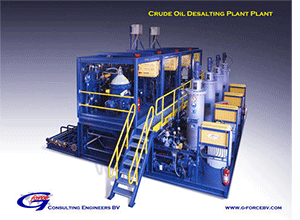Crude Oil Desalting Plant
The Plant
This plant is utilized to wash salt from crude oil. In cases where crude oil is highly contaminated with salt deposits in order to upgrade the market value of the crude the salt must be washed and removed. There are different types of technology to use for this application, the principle one being the injection and mixing of fresh water into the crude so that the salt is transferred from the crude into the water phase and then the water phase (containing the salt) is separated from the crude oil. Separating the salt water from the crude is the critical step especially where treated material specifications are involved. Simple 1-g API Separators can be used for this or so can high g-force centrifuges. In the case of G-force we apply 6000-g centrifuges to separate the salt water from the crude for the purpose of achieving the highest quality crude oil in the smallest operational footprint. The plants are designed under the new EU ATEX 2 norm for explosion proof equipment (Class 1 Div 2) for compliance involving Oilfield operations. A special design feature is the interconnecting pipe rack where all plant components centrally flange thereby minimizing space requirements, making installation and commissioning a quick, simple and easy task and providing excellent operations logic for all crude oil materials and wash water being fed into and processed through the various plant operational phases.
Principle of Operations
The feedstock is heated in a crude oil buffer tank to 65C and is picked up by the plant pumps for feeding into the plant process. An option on heating is for G-force to install our Heat Exchangers whereby hot water or steam is utilized to heat the crude, in a closed loop system, to any range from 50C to 98C. The crude oil is tested for salt content and calculations are done to determine the correct ratios of water to mix with the crude to remove all the salt. Having determined the wash water ratio the crude oil is fed into the plant at the correct metered rate while freshwater is also metered and mixed with the crude oil. The two streams (water & crude) are first mixed in a static mixer where treating chemicals are injected. The static mixed liquids (crude oil, water and treating chemicals) immediately enter the G-force RTR Dynamic Residence Blender to insure all the salt comes into contact with the wash water and is transferred from the crude to the water phase. Also during this procedure the blend of crude oil and wash water are reacted with the treating chemicals so that as the materials leave the RTR Blender they immediately enter the 6000 g-force High Speed Centrifuges to separate the crude oil and the wash water containing the salt. The cleaned crude oil is ready for transfer to storage and to market. Single component standard size G-force plants are designed for treatment capacities of 5 m/hr and 15 m/hr. Custom plants, to meet smaller and/or larger capacities, are built to the specific need of our customers such as the plant shown here having a 40 m3/hr capacity.
Serviceability
The plants are supplied with one-year of spares and come with a recommended maintenance schedule based on each 2000 hours of operations (4 times per year). All primary equipment is supplied as a complete package, including special tools, ready for installation on a level concrete pad. No other requirements are needed except to bring service points to the concrete pad for hook up purposes. G-force also supplies all climate buildings dimensionally specific for the plant size supplied.
Dimensions and Utilities
Basically, if the client orders a plant with a heat supply, the only utility requirement is electrical power and plant water. If the client has a heat supply only electricity and water are needed. The kW and water depend on plant size and options chosen, details of which are provided with our quotations. For the plant shown in the photo the electrical requirement is 125 kW of installed power.

